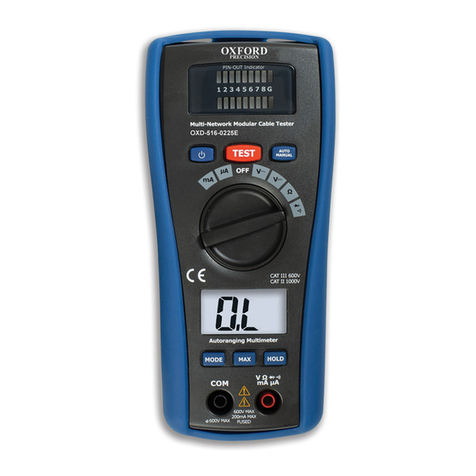
3
Safety can no longer be insured if the Voltage Tester:
• Shows obvious damage
• Does not carry out the desired measurements
• Has been stored for too long under unfavourable conditions
• Has been subjected to mechanical stress during transport.
All relevant statutory regulations must be adhered to when using this instrument
Safety Advice
• Depending on the internal impedance of the Voltage Tester there will be a different capability
of indicating the presence or absence of operating voltage in case of the presence of
interference voltage.
• A Voltage Tester of relatively low internal impedance, compared to the reference value of
100kΩ, will not indicate all interference voltages having an original voltage value above the
ELV (Extra Low Voltage) level. When in contact with the parts to be tested, the Voltage Tester
may discharge temporarily the interference voltage to a level below the ELV, but it will be back
to the original value when the Voltage Tester is removed.
• When the indication “voltage present” does not appear, it is highly recommended installing
earthing equipment before work.
• A Voltage Tester of relatively high internal impedance, compared to the reference value of 100kΩ,
may not permit to clearly indicate the absence of operating voltage in case of presence of interference
voltage.
• When the indication “voltage present” appears on a part that is expected to be disconnected
of the installation, it is highly recommended conrming by another means (e.g. use of an
adequate voltage detector, visual check of the disconnecting point of the electric circuit, etc.)
that there is no operating voltage on the part to be tested and to conclude that the voltage
indicated by the Voltage Tester is an interference voltage.
• A Voltage Tester declaring two values of internal impedance has passed a performance test
of managing interference voltages and is (within technical limits) able to distinguish operating
voltage from interference voltage and has a means to directly or indirectly indicate which type
of voltage is present.
Appropriate Usage
The instrument may only be used under those conditions and for those purposes for which it
was conceived. For this reason, in particular the safety references, the technical data including
environmental conditions and the usage in dry environments must be followed. When modifying
or changing the Voltage Tester, the operational safety is no longer ensured. The Voltage Tester
may only be opened by an authorised service technician, e.g. for fuse replacement. The Voltage
Tester is designed to be used by skilled persons and in accordance with safe methods of work.


























